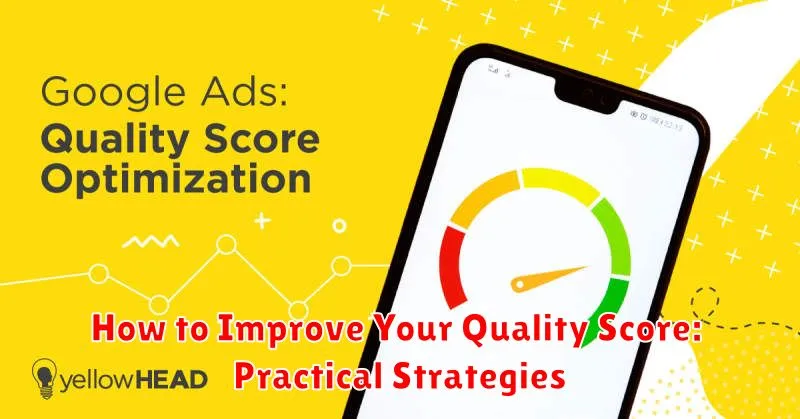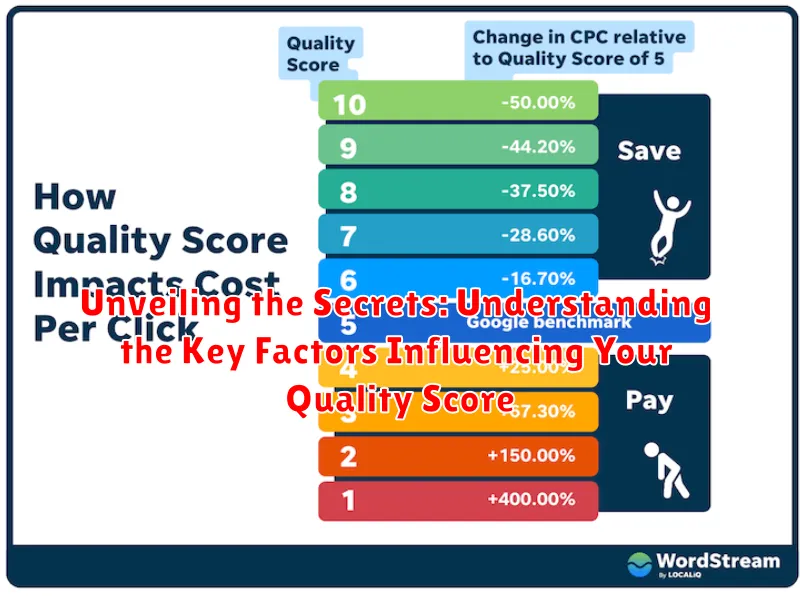Are you struggling to achieve the advertising results you desire? One crucial, often overlooked, aspect of successful online campaigns is your Quality Score. This metric, used by major platforms like Google Ads, directly impacts your ad rank, cost-per-click (CPC), and overall return on investment (ROI). Unveiling the secrets behind a high Quality Score is paramount for any marketer aiming to optimize their campaigns and achieve a competitive edge in the global market.
This article delves into the key factors that contribute to your Quality Score, providing a comprehensive understanding of how each element influences your performance. We will explore the significance of keyword relevance, landing page experience, and expected click-through rate (CTR). By mastering these elements, you can unlock the potential to improve your ad campaigns, lower your advertising costs, and ultimately, drive more qualified traffic to your website, regardless of your geographic location or target audience. We’ll explain how a strong Quality Score can enhance your brand visibility and contribute to your overall business growth, no matter where you operate in the world.
What is Quality Score and Why Does it Matter?
Quality Score is a diagnostic tool used by search engines like Google to measure the relevance and overall quality of your keywords, ads, and landing pages. It’s a numerical value, typically ranging from 1 to 10, with higher scores indicating better performance.
But why does it matter? A higher Quality Score can lead to significant benefits, including:
- Lower Costs: Improved scores can decrease the cost-per-click (CPC) you pay for your ads.
- Better Ad Positions: Higher scores often result in your ads being displayed in more prominent positions on the search results page.
- Increased ROI: By paying less and achieving better visibility, you can significantly improve your return on investment (ROI) from your advertising campaigns.
Essentially, Quality Score reflects how well your advertising efforts align with user intent and the search engine’s goals of providing relevant and helpful information. Neglecting it can lead to wasted ad spend and missed opportunities.
The Three Pillars of Quality Score: Relevance, Expected CTR, and Landing Page Experience
The Quality Score is fundamentally built upon three core pillars, each playing a crucial role in determining its overall value. These pillars are Ad Relevance, Expected Click-Through Rate (CTR), and Landing Page Experience. Understanding and optimizing each of these is critical for maximizing your advertising effectiveness and minimizing costs.
- Ad Relevance: This refers to how closely your ad matches the user’s search query. A highly relevant ad directly addresses the user’s intent.
- Expected CTR: This is a prediction of how likely users are to click on your ad when it’s shown. Higher CTRs generally indicate better ad performance.
- Landing Page Experience: This focuses on the quality and relevance of the landing page users are directed to after clicking your ad. A positive landing page experience leads to better conversions.
Each pillar is weighted differently and the exact weighting is not publicly disclosed, all of them significantly influence your Quality Score. Ignoring any one of these pillars can lead to a lower score and consequently, higher advertising costs.
Ad Relevance: Connecting Your Ads with User Intent
Ad relevance is a pivotal factor in determining your Quality Score. It signifies how closely your ad matches the user’s search query and intent.
Key Aspects of Ad Relevance:
- Keyword Relevance: Ensuring your keywords closely align with your ad copy and landing page content.
- Ad Copy Relevance: Crafting ad text that directly addresses the user’s search term and offers a solution to their needs.
- Landing Page Relevance: Providing a landing page that delivers on the promise made in your ad copy and offers relevant information or products.
A highly relevant ad demonstrates to the advertising platform that your ad is valuable to the user, increasing the likelihood of higher rankings and lower costs.
Assessing Your Ad Relevance:
Regularly review your search term reports to identify any irrelevant keywords triggering your ads. Refine your keyword targeting and ad copy to improve relevance.
Expected Click-Through Rate (CTR): Predicting Ad Performance
Expected Click-Through Rate (CTR) is a crucial component of Quality Score, representing a prediction of how likely your ad is to be clicked when shown for a given keyword. It’s not just about past performance; search engines assess the likelihood based on various factors, even before your ad is displayed.
A higher expected CTR generally indicates that your ad is relevant and appealing to users searching for that particular keyword. This positive signal contributes to a better Quality Score and, consequently, potentially lower costs and improved ad positioning.
Several elements influence expected CTR, including:
- Keyword Relevance: How closely the keyword matches the user’s search query.
- Ad Copy: The persuasiveness and relevance of your ad text.
- Historical CTR: Past performance data for your ads and keywords.
- Device Type: CTRs may vary depending on whether the user is on a desktop, mobile, or tablet device.
Optimizing your ads for a strong expected CTR is essential for maximizing your advertising ROI.
Landing Page Experience: Creating a Seamless User Journey
Landing page experience is a crucial component of your Quality Score, reflecting how relevant and useful your website is to users who click on your ads. Search engines like Google evaluate various factors to determine the quality of your landing page.
A positive landing page experience leads to higher Quality Scores, improved ad positions, and lower costs-per-click (CPCs). Conversely, a poor landing page experience can negatively impact your ad performance and overall campaign success.
Key Elements of a Good Landing Page Experience:
- Relevance: Ensure your landing page content directly relates to your ad copy and the keywords users searched for.
- Ease of Navigation: Users should be able to easily find the information they are looking for. A clear and intuitive site structure is essential.
- Transparency and Trustworthiness: Clearly display your contact information, privacy policy, and security measures.
- Mobile-Friendliness: Your landing page should be optimized for mobile devices, providing a seamless experience for users on smartphones and tablets.
- Page Speed: A fast-loading landing page is crucial for user satisfaction and preventing bounce rates.
How to Improve Your Quality Score: Practical Strategies

Improving your Quality Score requires a multifaceted approach focusing on the core components: ad relevance, expected click-through rate (CTR), and landing page experience.
Enhance Ad Relevance
Refine your keyword targeting by using tightly themed ad groups. Ensure your ad copy directly reflects the keywords you are bidding on. Use negative keywords to filter out irrelevant searches.
Boost Expected CTR
Write compelling and persuasive ad copy that encourages clicks. A/B test different ad variations to identify the most effective messaging. Leverage ad extensions to provide additional information and increase visibility.
Optimize Landing Page Experience
Ensure your landing page is relevant to the ad copy and keywords. Provide a clear and concise message, making it easy for users to find what they’re looking for. Optimize for mobile devices and ensure fast loading times.
The Impact of Keywords on Quality Score
Keywords are fundamental to your Quality Score. The selection, organization, and integration of keywords profoundly influence how relevant your ads are to user searches.
Keyword Relevance is Paramount
Your keywords should directly align with your ad copy and landing page content. Mismatched keywords negatively impact Quality Score, signaling to the ad platform a disconnect between user intent and your offerings.
Keyword Grouping and Organization
Organize your keywords into tightly themed ad groups. This structure allows for more specific ad copy and landing pages, ultimately boosting relevance and improving your Quality Score. Avoid stuffing unrelated keywords into single ad groups.
Negative Keywords: A Protective Measure
Implement negative keywords to prevent your ads from showing for irrelevant searches. This refining process focuses your ad spend on the most qualified traffic, positively influencing your overall Quality Score by improving CTR and relevance metrics.
Quality Score Monitoring and Optimization: A Continuous Process
Quality Score is not a one-time fix but an ongoing endeavor. Consistent monitoring and optimization are crucial for maintaining and improving your scores over time.
Regularly review your Quality Scores at the keyword level to identify areas for improvement. Keep track of trends and patterns to understand how changes to your campaigns impact your scores. Utilize the reporting tools available in your advertising platform to gain insights into the individual components of your Quality Score: Expected CTR, Ad Relevance, and Landing Page Experience.
Based on your monitoring, make data-driven adjustments to your campaigns. This could involve refining your keyword targeting, rewriting ad copy, or improving your landing page. Implement A/B testing to evaluate different approaches and optimize your campaigns for better performance.
Remember that Quality Score is dynamic and influenced by various factors, including competitor activity and search engine algorithm updates. Therefore, continuous monitoring and optimization are essential for staying ahead and maximizing your advertising effectiveness.
Common Misconceptions About Quality Score
Several misconceptions surround Quality Score, often leading to ineffective strategies. One common myth is that a high Quality Score guarantees top ad positions. While it’s a significant factor, bid amount and ad rank also play crucial roles.
Another misconception is that Quality Score is a static number. It’s dynamic, constantly updated based on performance. Regular monitoring and adjustments are necessary.
Many also believe that pausing and restarting a campaign resets the Quality Score. This is generally false; historical data influences future scores. A temporary pause does not erase past performance.
Finally, a widespread belief is that Quality Score is only relevant for Google Ads. While primarily associated with Google, similar metrics exist in other advertising platforms, emphasizing relevance and user experience.
Quality Score in the Context of Modern Advertising

In today’s dynamic digital landscape, Quality Score remains a crucial metric, albeit within an evolving advertising ecosystem. While its core function of evaluating ad quality and relevance persists, its impact is now intertwined with advanced bidding strategies, audience targeting, and automated optimization tools. Modern advertising platforms leverage machine learning to refine ad placements and deliver personalized experiences, potentially reducing reliance on manual Quality Score adjustments.
However, neglecting Quality Score is a mistake. A high score still contributes to lower costs, improved ad positions, and a competitive edge. Advertisers must understand how Quality Score interacts with modern bidding algorithms and audience segmentation techniques. Optimizing for both relevance and user experience remains paramount for achieving advertising success in today’s sophisticated environment. Focusing on providing value to the user through highly relevant ads and seamless landing page experiences is vital.

